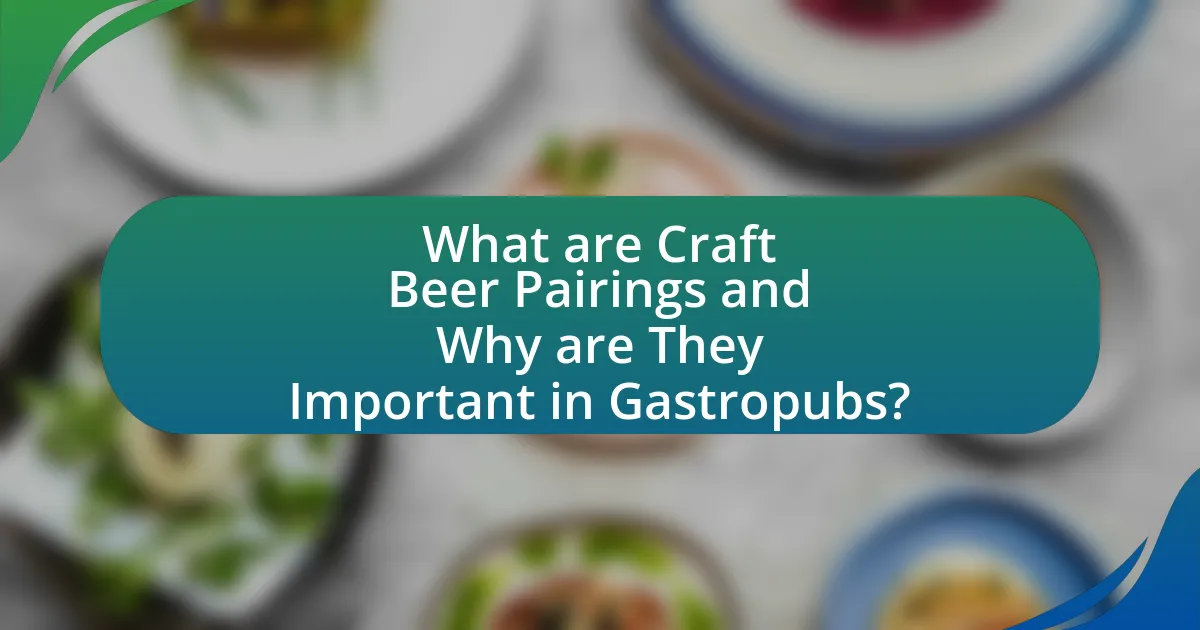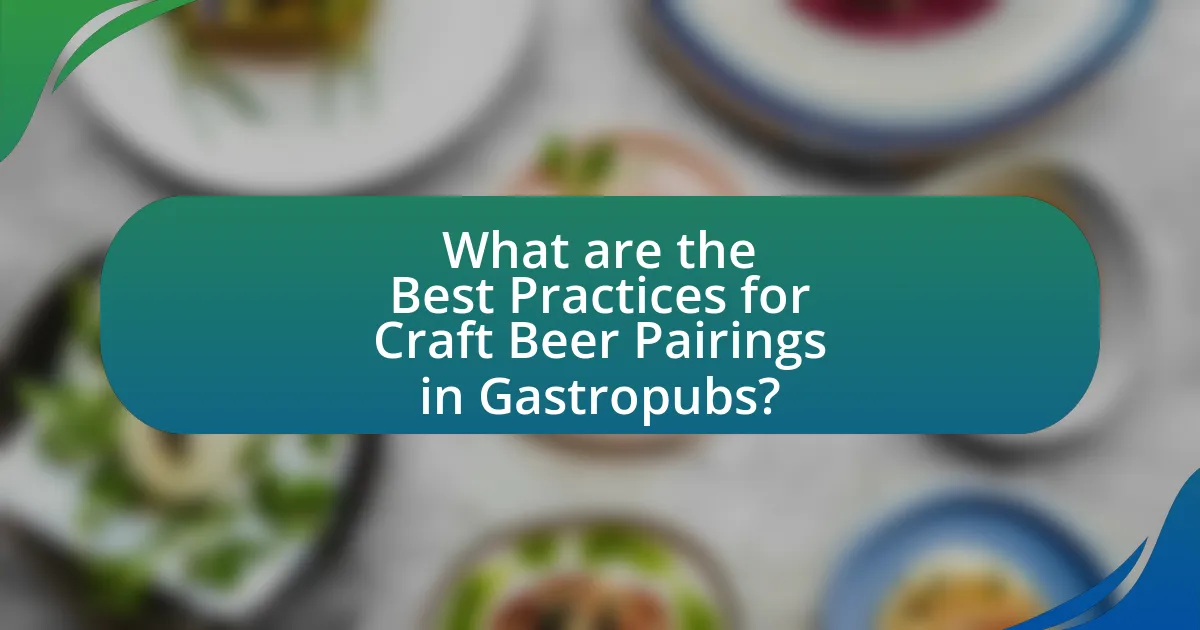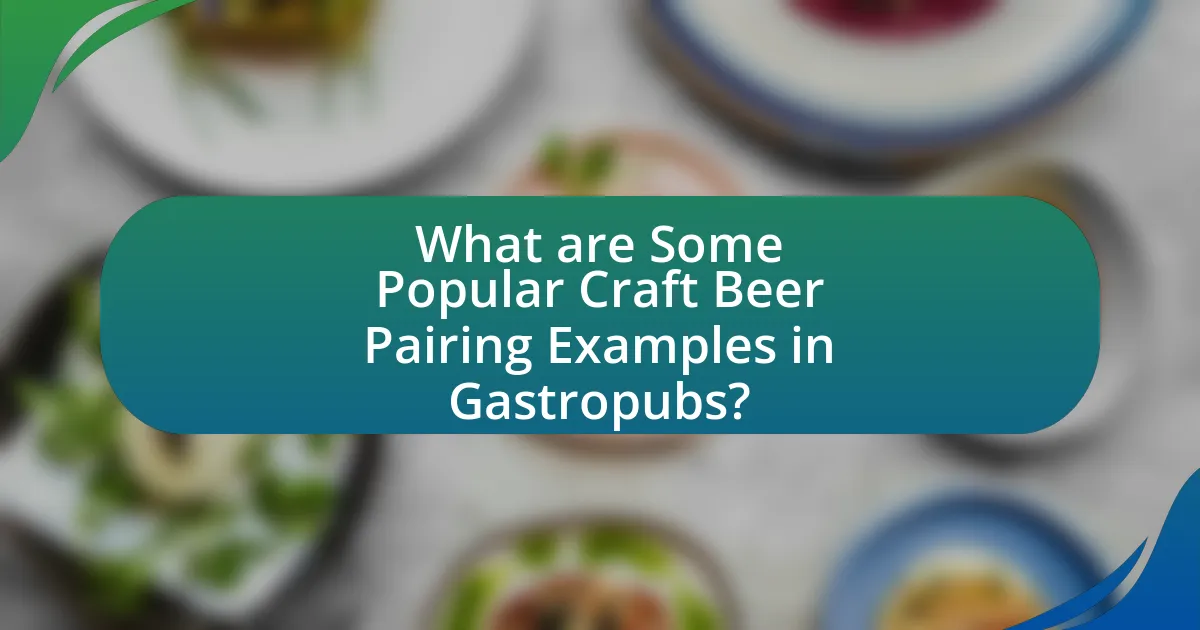Craft beer pairings are the deliberate selection of specific craft beers to enhance the flavors of food served in gastropubs, significantly elevating the dining experience. These pairings consider various flavor profiles, such as bitterness, sweetness, and acidity, to create harmonious combinations that improve taste perception and overall satisfaction. The article explores how different beer styles complement various cuisines, the role of craft beer in gastropub culture, and best practices for creating successful pairings. Additionally, it addresses common mistakes to avoid and offers tips for enhancing the craft beer pairing experience, making it a valuable resource for both patrons and culinary professionals.

What are Craft Beer Pairings and Why are They Important in Gastropubs?
Craft beer pairings are the intentional selection of specific craft beers to complement and enhance the flavors of food served in gastropubs. These pairings are important because they elevate the dining experience by creating harmonious flavor profiles, which can enhance both the beer and the food. Research indicates that pairing food with the right beer can improve taste perception and overall satisfaction, as flavors interact in ways that can amplify the enjoyment of both components. For example, a hoppy IPA can cut through the richness of a fatty dish, while a malty stout can complement the sweetness of a dessert, demonstrating the significance of thoughtful pairings in gastropub cuisine.
How do Craft Beer Pairings Enhance the Dining Experience?
Craft beer pairings enhance the dining experience by complementing and elevating the flavors of food. The unique characteristics of craft beers, such as their varied aromas, bitterness, and sweetness, can enhance the taste profiles of dishes, creating a more harmonious and enjoyable meal. For instance, a hoppy IPA can cut through the richness of a fatty dish, while a malty stout can add depth to desserts. Studies have shown that food and beverage pairings can significantly influence taste perception, making the overall dining experience more satisfying and memorable.
What Flavor Profiles are Considered in Craft Beer Pairings?
Craft beer pairings consider several flavor profiles, including bitterness, sweetness, acidity, and maltiness. Bitterness from hops can complement spicy dishes, while sweetness from malts can balance rich or fatty foods. Acidity in certain beers, like sour ales, can enhance the flavors of acidic foods such as salads or seafood. Additionally, maltiness can provide a robust backdrop for grilled meats or barbecued dishes. These profiles are essential for creating harmonious pairings that elevate the overall dining experience at gastropubs.
How do Beer Styles Complement Different Types of Cuisine?
Beer styles complement different types of cuisine by enhancing flavors and balancing taste profiles. For instance, hoppy IPAs can cut through the richness of fatty foods like fried chicken, while malty stouts pair well with chocolate desserts, creating a harmonious experience. Additionally, wheat beers often complement lighter dishes such as salads or seafood, as their refreshing qualities enhance the meal without overpowering it. This pairing principle is supported by the concept of flavor matching, where the bitterness of certain beers can offset sweetness or richness in food, leading to a more enjoyable dining experience.
What Role Does Craft Beer Play in Gastropub Culture?
Craft beer is integral to gastropub culture as it enhances the dining experience through unique flavor pairings and local sourcing. Gastropubs often curate a selection of craft beers that complement their food menus, allowing patrons to enjoy a cohesive culinary experience. This focus on craft beer not only supports local breweries but also reflects a commitment to quality and innovation in food and beverage offerings. Studies show that establishments featuring craft beer can increase customer satisfaction and loyalty, as consumers appreciate the artisanal approach and variety that craft beers provide.
How Have Gastropubs Evolved to Include Craft Beer?
Gastropubs have evolved to include craft beer by integrating local and artisanal brews into their beverage offerings, enhancing the overall dining experience. This shift began in the late 20th century as the craft beer movement gained momentum, with gastropubs recognizing the demand for unique and high-quality beer options that complement their gourmet food menus. According to the Brewers Association, the number of craft breweries in the United States grew from 1,500 in 2000 to over 8,000 by 2019, reflecting a significant cultural shift towards craft beer consumption. Gastropubs have capitalized on this trend by curating beer lists that feature local breweries, seasonal selections, and innovative styles, thereby creating a more dynamic pairing experience for patrons.
What Unique Experiences Do Gastropubs Offer with Craft Beer?
Gastropubs offer unique experiences with craft beer by combining high-quality food with a curated selection of local and artisanal brews. This pairing enhances the dining experience, as gastropubs often feature seasonal menus that complement specific craft beers, allowing patrons to enjoy flavors that are thoughtfully matched. For instance, a gastropub may serve a rich stout alongside a chocolate dessert, highlighting the beer’s roasted notes. Additionally, many gastropubs host beer tastings and events, providing opportunities for customers to learn about brewing techniques and the origins of different beers, further enriching their experience. This focus on craft beer not only elevates the culinary offerings but also fosters a community atmosphere where beer enthusiasts can share their passion.

What are the Best Practices for Craft Beer Pairings in Gastropubs?
The best practices for craft beer pairings in gastropubs include understanding flavor profiles, balancing intensity, and considering regional pairings. Understanding flavor profiles involves matching the beer’s characteristics, such as bitterness, sweetness, and acidity, with the dish’s flavors to enhance the overall dining experience. Balancing intensity ensures that neither the beer nor the food overpowers the other; for example, a robust stout pairs well with rich, hearty dishes, while a light lager complements delicate seafood. Additionally, considering regional pairings can create a cohesive dining experience, as local beers often pair well with regional cuisine, reflecting the terroir and culinary traditions. These practices are supported by the growing trend of gastropubs focusing on craft beer to elevate their menus, as evidenced by the increasing number of establishments that curate beer lists specifically designed to enhance food offerings.
How Can Chefs and Brewers Collaborate for Optimal Pairings?
Chefs and brewers can collaborate for optimal pairings by engaging in joint tastings and menu development sessions that focus on flavor profiles. This collaboration allows chefs to understand the nuances of different craft beers, such as bitterness, sweetness, and aroma, which can enhance their dish creations. For instance, a chef might create a dish that complements the hoppy notes of an IPA, while a brewer can suggest specific beer styles that pair well with the chef’s culinary offerings. Research indicates that successful pairings can elevate the dining experience, as seen in gastropubs where curated beer and food pairings lead to increased customer satisfaction and repeat visits.
What Techniques Can Be Used to Create Memorable Pairings?
Techniques to create memorable pairings include understanding flavor profiles, utilizing complementary and contrasting tastes, and considering texture and aroma. Flavor profiles can be analyzed by identifying the key notes in both the craft beer and the food, allowing for pairings that enhance each other. Complementary pairings, such as a hoppy IPA with spicy dishes, can elevate the overall experience, while contrasting pairings, like a rich stout with a light dessert, can create a dynamic balance. Additionally, texture plays a crucial role; for instance, pairing a creamy beer with crispy food can enhance mouthfeel. Aroma also influences perception, as aromatic beers can enhance the overall sensory experience when paired with fragrant dishes. These techniques are supported by culinary studies that emphasize the importance of sensory interaction in food and beverage pairings.
How Can Seasonal Ingredients Influence Pairing Choices?
Seasonal ingredients significantly influence pairing choices by enhancing flavor compatibility and freshness in dishes served at gastropubs. Utilizing ingredients that are in season ensures that the flavors are at their peak, which allows for more harmonious pairings with craft beers. For example, spring vegetables like asparagus pair well with lighter beers such as pilsners, while hearty winter root vegetables complement robust stouts. This alignment between seasonal produce and beer styles not only elevates the dining experience but also reflects local agricultural cycles, promoting sustainability and supporting local farmers.
What Common Mistakes Should Be Avoided in Craft Beer Pairing?
Common mistakes to avoid in craft beer pairing include ignoring the flavor profiles of both the beer and the food, which can lead to mismatched tastes. For instance, pairing a light lager with a heavily spiced dish may result in the beer being overwhelmed by the food’s flavors. Additionally, not considering the carbonation level can affect the overall experience; high carbonation can enhance or detract from certain dishes. Another mistake is failing to experiment with regional pairings, as local beers often complement local cuisine effectively. Lastly, relying solely on personal preference without considering the characteristics of the beer and food can lead to suboptimal pairings.
How Can Overpowering Flavors Ruin a Pairing?
Overpowering flavors can ruin a pairing by overshadowing the subtleties of both the food and the beverage, leading to a disjointed dining experience. When a flavor is too intense, it can mask the intended taste profiles, preventing the consumer from fully appreciating the complexity of the pairing. For instance, a heavily spiced dish may dominate a delicate beer, resulting in a lack of balance and harmony. This imbalance can detract from the overall enjoyment, as the nuances of both elements are lost.
What Misconceptions Exist About Beer Pairing?
Misconceptions about beer pairing include the belief that only certain types of beer can be paired with specific foods, which limits the potential for diverse combinations. Many people think that lighter beers should only be paired with lighter dishes, while darker beers are reserved for heavier meals. However, studies show that flavor profiles, rather than color or type, are more critical in creating successful pairings. For instance, a hoppy IPA can complement spicy foods, while a malty stout can enhance the flavors of chocolate desserts. This understanding allows for a broader range of pairings that can elevate the dining experience at gastropubs.

What are Some Popular Craft Beer Pairing Examples in Gastropubs?
Popular craft beer pairing examples in gastropubs include IPAs with spicy dishes, stouts with chocolate desserts, and pale ales with grilled meats. IPAs, known for their hoppy bitterness, complement the heat of spicy foods, enhancing the overall flavor experience. Stouts, characterized by their rich, roasted flavors, pair excellently with chocolate desserts, creating a harmonious balance between sweetness and bitterness. Pale ales, with their moderate hop profile, work well with grilled meats, as the beer’s citrus notes can cut through the richness of the meat, making each bite more enjoyable. These pairings are commonly featured in gastropubs to elevate the dining experience by enhancing the flavors of both the food and the beer.
How Do Specific Dishes Pair with Different Beer Styles?
Specific dishes pair with different beer styles based on complementary flavors and textures. For example, rich and fatty foods like burgers pair well with hoppy IPAs, as the bitterness cuts through the fat, enhancing the overall taste. Conversely, lighter dishes such as salads or seafood are best matched with crisp lagers or wheat beers, which provide a refreshing contrast without overpowering the dish. Studies show that pairing beer with food can enhance the dining experience by balancing flavors; for instance, a malty stout can complement chocolate desserts, creating a harmonious blend of sweetness and bitterness.
What are the Best Pairings for Appetizers?
The best pairings for appetizers include craft beers that complement the flavors of the dishes served. For example, light lagers pair well with fried calamari, while IPAs enhance the taste of spicy buffalo wings. Stouts are ideal for rich, creamy appetizers like cheese dips, and wheat beers complement fresh salads and seafood. These pairings are supported by the principle that contrasting flavors can enhance the overall dining experience, as noted in various culinary studies.
Which Main Courses Benefit Most from Craft Beer Pairings?
Main courses that benefit most from craft beer pairings include grilled meats, spicy dishes, and rich, creamy sauces. Grilled meats, such as steak or barbecue, pair well with hoppy IPAs that enhance the smoky flavors. Spicy dishes, like Thai or Indian cuisine, are complemented by wheat beers or pale ales that balance heat with refreshing notes. Rich, creamy sauces, often found in pasta or seafood dishes, are best paired with malty beers like brown ales, which provide a contrast to the creaminess. These pairings enhance the overall dining experience by creating harmonious flavor profiles.
What Tips Can Enhance Your Craft Beer Pairing Experience?
To enhance your craft beer pairing experience, focus on matching the beer’s flavor profile with the dish’s characteristics. For instance, hoppy IPAs complement spicy foods, while malty stouts pair well with rich desserts. Research indicates that flavor compatibility can significantly elevate the overall dining experience, as highlighted in a study by the Brewers Association, which emphasizes the importance of balancing bitterness, sweetness, and acidity in pairings. Additionally, consider the beer’s carbonation level; higher carbonation can cleanse the palate, making it ideal for fatty or fried foods.
How Can You Experiment with Pairings at Home?
To experiment with pairings at home, start by selecting a variety of craft beers and foods that complement or contrast each other. For instance, pairing a hoppy IPA with spicy dishes can enhance flavors, while a rich stout may go well with chocolate desserts. Research indicates that contrasting flavors can create a more dynamic tasting experience, as seen in studies on flavor profiles and sensory evaluation. By keeping a tasting journal to note your observations, you can refine your pairings over time, making the process both enjoyable and educational.
What Resources are Available for Learning More About Beer Pairing?
Books, online courses, and websites are valuable resources for learning more about beer pairing. Notable books include “The Beer Bible” by Jeff Alworth, which provides comprehensive insights into beer styles and pairing suggestions, and “Tasting Beer” by Randy Mosher, which explores flavor profiles and food pairings. Online platforms like Coursera and Udemy offer courses specifically focused on beer and food pairing, often taught by industry experts. Additionally, websites such as BeerAdvocate and the Brewers Association provide articles, guides, and community forums that discuss various pairing techniques and recommendations, making them excellent resources for enthusiasts and professionals alike.




